Plagioclase feldspar (Labradorite) from Le Puy-En-Velay, Haute Loire, France
- Details
- Created: Thursday, 23 November 2017 21:25
The very light-yellow stone described in this report was reported as a bytownite-anorthite plagioclase feldspar mined in the Le Puy-En-Velay area in south of Auvergne in France. Plagioclases form the albite (Na end-member) - anorthite (Ca end-member) solid-solution where the bytownite is one of the intermediate members. As the anorthite/albite ratio increases, the members are considered as albite (An:<10%), oligoclase (An:10-30%), andesine (An:30-50%), labradorite (An:50-70%), bytownite (An:70-90%), anorthite (An:>90%). This partitioning is theoritical and the nature makes the things somewhat more complex, for instance bytownite and anorthite may include a third feldspar, the orthoclase. Bytownite-anorthite gemstones are much rarer than labradorite and andesine, so the stone (figure 1) was attractive, not for its appearance but for its chemical composition as a bytownite-anorthite variety.
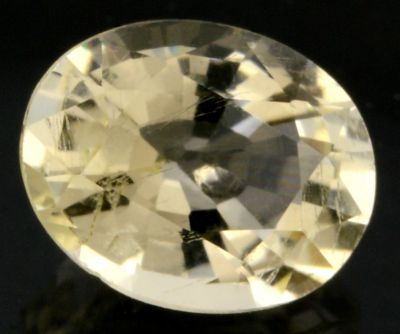 Figure 1. The 0.85 ct very light-yellow plagioclase feldspar, reported
Figure 1. The 0.85 ct very light-yellow plagioclase feldspar, reportedas bytownite but is finaly a labradorite.
| Shape | oval |
| Size | 6.9 x 5.5 x 4.0 mm |
| Color | very-light-yellow |
| Lustre | vitreous |
| Weight | 0.85 ct |
| SG | 2.66 [andesine: 2.65-2.69, labradorite: 2.67-2.73, bytownite: 2.69-2.75] |
| RI | 1.558 - 1.565 [andesine: 1.542 - 1.562, labradorite: 1.553 - 1.574, bytownite: 1.561 - 1.584] |
| DR | 0.007 B+ [andesine: 0.006-0.010 B+/B-, labradorite: 0.007-0.012 B+, bytownite: 0.009-0.012 B-] |
| Pleochroism | not observable |
| Polariscope / Conoscope | light/dark 4 times per 360° rotation, biaxial interference figure with conoscope, twinings (see figure 2) |
| SWUV | faint red |
| LWUV | inert |
| Magnetic susceptibility N52 | inert |
| Chelsea filter | inert - very-light-yellow |
Table 1. Observational and measured properties
The figure 2 shows the stone in the polariscope in a direction which is almost perpendicular to that where were observed the biaxial interference figures. While rotating the stone, two black bands appear and disappear. Although the quality of the picture is rather poor, the alternate black and white bands are well defined. These bands result of parallel layers of twinned crystals which are rather common in feldspars.
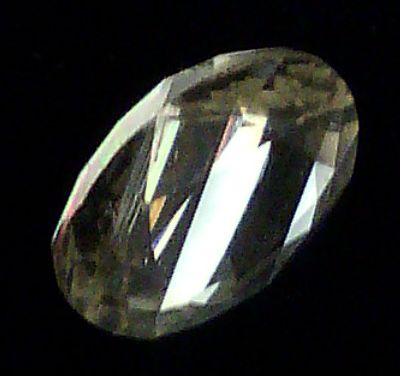 Figure 2. The stone viewed in the polaricope shows alternate black
Figure 2. The stone viewed in the polaricope shows alternate blackand white bands that result of parallel layers of twinned crystals.
Infrared reflectance spectroscopy:
The IR reflectance spectrum (figure 3) was collected from the table. It shows a characteristic plagioclase feldspar pattern. It is quite tricky to deduce the Anorthite/Albite ratio from the spectrum but the computed search in the spectra database gave all matches with high confidence to labradorite but also to some andesine that might be in fact labradorite. The 541 cm-1 band is consitent with other labradorite but to high for bytownite whose the corresponding band is around 538 cm-1 as well as for anorthite. Here, one has only some indications, not a true determining. The interesting point is that these indications are consistent with that of classical gemology (RI, DR, optical character and sign, SG).
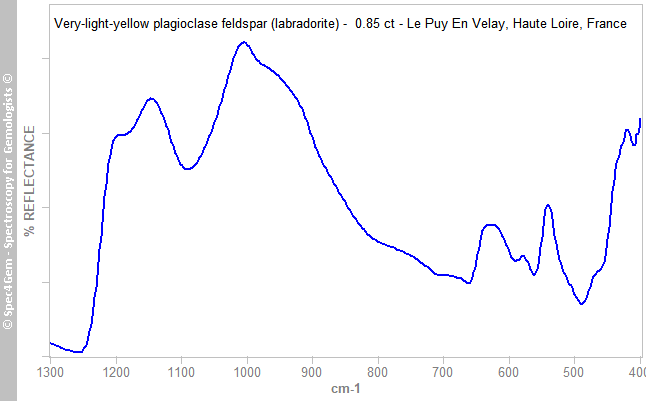 Figure 3. The IR reflectance spectrum of the 0.85 ct gemstone shows a characteristic plagioclase feldspar spectrum. The band at 541 cm-1 is generally found in labradorite than in bytownite or anorthite where it is located around 538 cm-1.
Figure 3. The IR reflectance spectrum of the 0.85 ct gemstone shows a characteristic plagioclase feldspar spectrum. The band at 541 cm-1 is generally found in labradorite than in bytownite or anorthite where it is located around 538 cm-1. UV-VIS-NIR spectroscopy:
The UV-Vis-NIR spectrum (figure 4) was collected with the light path perpendicular to the stone's table. The spectrum shows iron features[1], Fe3+ in the tetrahedral Si/Al site at 382, 420 and 445 nm and possibly Fe2+ in the Ca site above 800 nm.
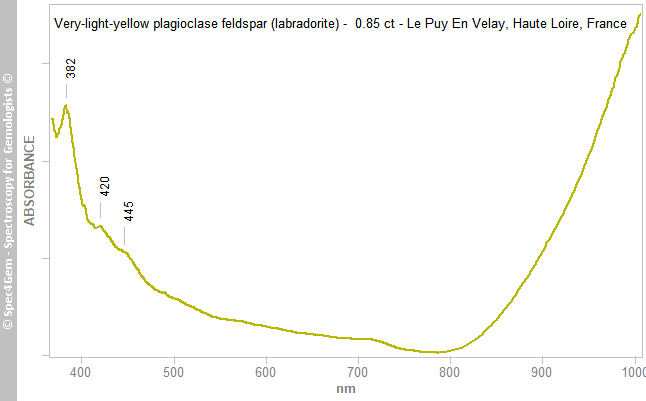 Figure 4. The UV-Vis-NIR spectrum of the 0.85 ct plagioclase feldspar gemstone shows Fe3+ features at 382, 420 and 445 nm and possibly Fe2+ above 800 nm.
Figure 4. The UV-Vis-NIR spectrum of the 0.85 ct plagioclase feldspar gemstone shows Fe3+ features at 382, 420 and 445 nm and possibly Fe2+ above 800 nm.Photoluminescence spectroscopy:
The photoluminescence spectra (figure 5) of this 0.85 ct plagioclase feldspar gemstone were acquired with two excitation sources: 405 nm (pink spectrum) and 254 nm (red spectrum), in both setups the emissions were quite low. The 405 nm excitation induces two emissions: 560 nm ascribed to Mn2+ and 700 nm ascribed to Fe3+ in the tetrahedral Si/Al site (see Gorobets & Rogojine[2]). The 254 nm excitation produces a single emission peaking at 725 nm related to Fe3+ in the tetrahedral Si/Al site.
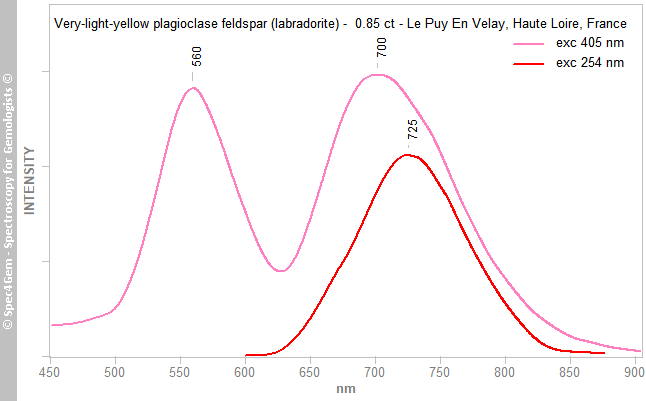 Figure 5. Photoluminescence spectra of the 0.85 ct plagioclase feldspar gemstone acquired with two excitation sources: 405 nm (pink spectrum) and 254 nm (red spectrum). The 405 nm excitation induces two emissions: 560 nm ascribed to Mn2+ and 700 nm ascribed to Fe3+ in the tetrahedral Si/Al site. The 254 nm excitation produces a single emission peaking at 725 nm related to Fe3+ in the tetrahedral Si/Al site.
Figure 5. Photoluminescence spectra of the 0.85 ct plagioclase feldspar gemstone acquired with two excitation sources: 405 nm (pink spectrum) and 254 nm (red spectrum). The 405 nm excitation induces two emissions: 560 nm ascribed to Mn2+ and 700 nm ascribed to Fe3+ in the tetrahedral Si/Al site. The 254 nm excitation produces a single emission peaking at 725 nm related to Fe3+ in the tetrahedral Si/Al site.Conclusion:
Classical gemology properties put this 0.85 ct very light-yellow plagioclase feldspar in the labradorite variety rather than the bytownite-anorthite one where the properties such as RI, DR are higher and optical sign is negative. IR reflectance spectrum indicates the same (a complete determining would require chemical analysis).
The UV-Vis-NIR spectroscopy shows the material owes its yellow color to Fe3+ and contains also iron as Fe2+.
Luminescence spectroscopy revealed also the presence of Mn2+ in addition to that of Fe3+.
[1] Feldspar Visible Spectra - List of Visible Data Files on the Caltech Mineral Spectroscopy Server
[2] Luminescent Spectra of Minerals, Boris S. Gorobets and Alexandre A. Rogojine, Moscow, 2002, ISBN: 5901837053

